We live in a world where everything around us is automated. Even our basic kitchen knife sharpeners are using automation nowadays.
We plug them in and pull the knife through a few times, smooth the edges, polish, and there we have it a razor-sharp blade. So picking the winner from the “Manual vs Electric Knife Sharpener” debate should be easy, right?
Actually, it is not as there are quite a few factors to take into account when choosing between the two. Some even settle on having both!
Summary Both manual and electric knife sharpeners have their own advantages and disadvantages. While electric knife sharpeners are generally faster, more convenient and efficient, manual knife sharpeners are cheaper, maintenance-free, and provide greater control and precision over the sharpening process.
Manual vs Electric Knife Sharpener: A Quick Look
Let me tell you something before you start rolling your eyeballs at the differences. There’re facts about both sharpeners that you may not know.
1. Electric Knife Sharpener
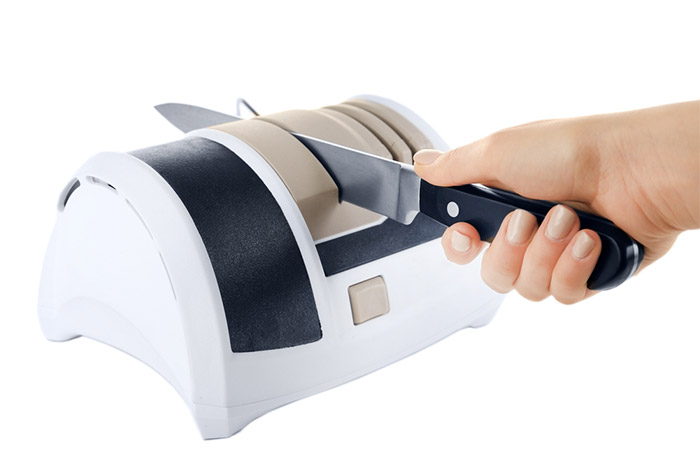
These are made by different brands and although the designs may look different just like a toaster or kettle they all work on the exact same concept type.
The device automatically sharpens your knives for you all you have to do is hold and guide the blade through. It works in three stages a coarse grind, a fine grind, and then an extra fine grind.
It is also quick and gets the job done in a fraction of the time, giving a smooth, burr-free, and straight edge.
2. Manual Knife Sharpener
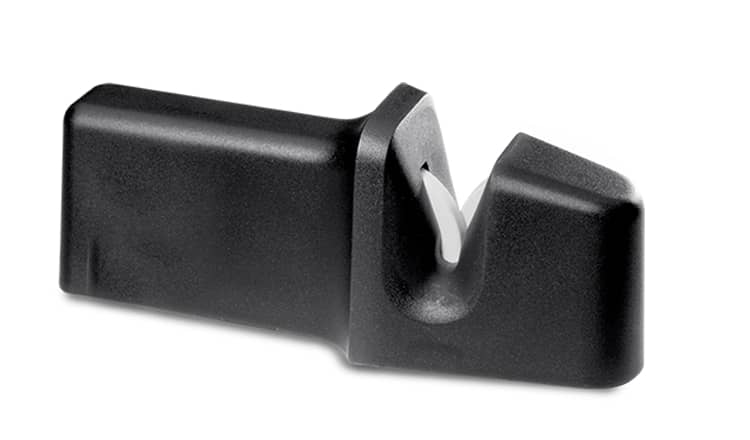
There are three different types of manual knife sharpeners:
Steel Sharpeners
These are long steel rods that most chefs have and will use just before or after they utilize their knives. They are great for honing the blade of the knife to get that supercut just before use and touching it up after use.
Block Sharpeners
Also called sharpening stones or whetstones, knife block sharpeners are excellent for very blunt knives. They are also very handy for sharpening other things such as razor blades and scissors.
Manual Sharpeners
They are usually plastic handheld devices that are a smaller version of the electric sharpener. They have a handle and a few sharpening slots much like the grinding wheels on their electric counterparts.
A lot of top chefs will have one of these as they are easy to travel with.
3. Using an Electric Knife Sharpener
These sharpeners are great to keep in your kitchen. Modern electric sharpeners are very handy, easy to use, and quick to get the cutting edge on the knife that is required.
Working Procedures
These are the steps to using an electric sharpener
- Get to know the device, read the manual, and find out what all the different sections are for. Identify each part of the electric knife sharpener.
- Ready the knives you want to sharpen
- Gently feel along the edges of the knife for any burrs the edge should feel quite smooth
- Plug it in, make sure the on/off button is facing the person about to use the device, and then switch it on.
- Starting on the left-hand side of the wheel (usually marked coarse or 1) place the knife in the center of the grind slot.
- Gently lower it to the hilt of the knife with the tip sticking out of the other side until the grinding noise can be heard.
- Pull the knife back towards you arcing it up following the pattern of the knife’s design.
- Do this again at least twice on both sides of the coarse grinding section before moving on to the next stage, which is usually marked as fine or 2.
- Repeat the motion as for stage 1 the same amount of times you pulled the knife through in stage 1.
- Repeat the procedure on the third stage usually marked extra fine, polish, or 3.
- You’re almost done using an electric sharpener! Once done turn off the device and rinse the knife in some warm soapy water before using it.
Advantages
- Fast sharpening process
- Removes a lot more burs to keep knives precision sharp
- Different modes to hone or to just touch up the blade
- The blade glides through smoothly and helps get better flavor.
In practice, these tools outperform their manual counterparts when much time is not to be consumed, and you don’t have a knack for such jobs.
Sounds like you got an easy take from the ‘manual vs electric knife sharpener’ debate! But, not right away! Their limitations may not put you at ease.
Limitations
- If there is no power, you cannot use the device
- Not easy to travel with
- They can be quite expensive
- Needs more storage space
- As it is electric there are more parts to go wrong with it
4. Using a Manual Sharpener
Manual or pull through sharpeners are still very much in demand, especially among those who want to make energy efficient lifestyle choices.
Working Procedures
- Always ensure the knife sharpener is kept in good condition
- Holding the sharpener securely and on a flat surface put the base of the blade into the middle of the slot and then pull it back and move the handle upward as you pull the blade through the sharpening blocks. Follow the flow of the knife’s design.
- Turn it around and repeat the process on the other side of the blade.
- If the manual sharpener has another grinding slot use it to hone and or polish the blade.
Advantages
- No need for electricity so you don’t have to plug it in to use
- Small, compact, and easy to store
- Easy to use
- Easy to travel with
- Not very expensive
Limitations
- There are usually only one or two grinding settings
- Manual and requires more effort to sharpen a set of knives
Electric vs Manual Knife Sharpener: What’s the Key?
What to choose when considering manual vs electric knife sharpeners? It is actually a matter of personal preference and what your needs call for.
Since manual sharpeners are not too expensive it is always best to start with them, especially if you are on a budget. They can work just as well as electric ones and they were there for a long time before their electric counterparts came out!
So, if it is all you can afford then stick with the old tried and tested.
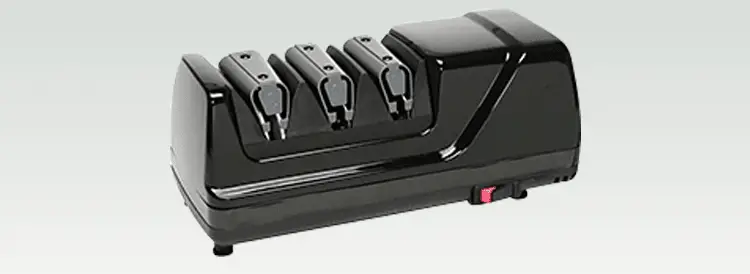
Electric sharpeners are great to sharpen your knife if you can afford them. They sharpen, hone, and buff up a knife to a level of precision that’s often required in advanced use. But they can be expensive and are not very energy efficient if you do not buy the right one. Also, a lot more can go wrong with them as it does with all electrical appliances.
When talking about electric knife sharpener vs manual, both have their own set of pros and cons. Which one you buy is a matter of choice and what suits both your lifestyle and budget.
The best thing to do, if you can, is to have both that way if the power goes out or the electric device fails there is always the manual one.
FAQs
1. Can knife sharpeners ruin my knives?
Ans. Knife sharpeners are there to protect your knives and keep them from becoming dull and ineffective. But you can damage your knives if you use the wrong type of sharpener and/or the wrong way. You could also damage the blade or remove too much metal if you use too much pressure while sharpening.
2. Can I sharpen my knives everyday?
Ans. How often you need to sharpen your knives depends on how frequently you use them and the type of tasks you use them for. If you use them every day for heavy-duty tasks like cutting through tough meats or chopping through dense vegetables, you’ll have to sharpen them more often. But if your knives are used for lighter applications such as slicing fruits and vegetables, sharpening them once every few months will do.
However, don’t try to sharpen everyday unnecessarily because whenever you sharpen a knife, you’re essentially removing a small amount of metal from the blade to create a new edge. Doing this too frequently can shorten the life of your knife, as it will eventually wear down the blade and make it thinner over time.
3. Should I sharpen my knife wet or dry?
Ans. This depends on the type of sharpener you are using. If you’re using a whetstone, you should use water or honing oil to lubricate the stone and keep the blade and stone clean during the sharpening process. The water or oil helps to remove the metal particles and debris from the stone and prevents it from clogging up.
But for using an electric or manual sharpening tool, you better go dry since adding any type of lubricant could interfere with the sharpening process and potentially damage the tool.
4. Should I wash a knife after sharpening?
Ans. Yes you should in order to remove any metal particles or debris that may have accumulated on the blade during the sharpening process. After all, sharpening means shaving off some bits of the blade and if not washed, these particles can build up on the blade and affect its performance, and may even cause rust or corrosion over time.
It’s also a good idea to store your newly sharpened knife in a knife block or sheath to protect the blade and prevent it from making contact with other objects that could cause damage or dullness.

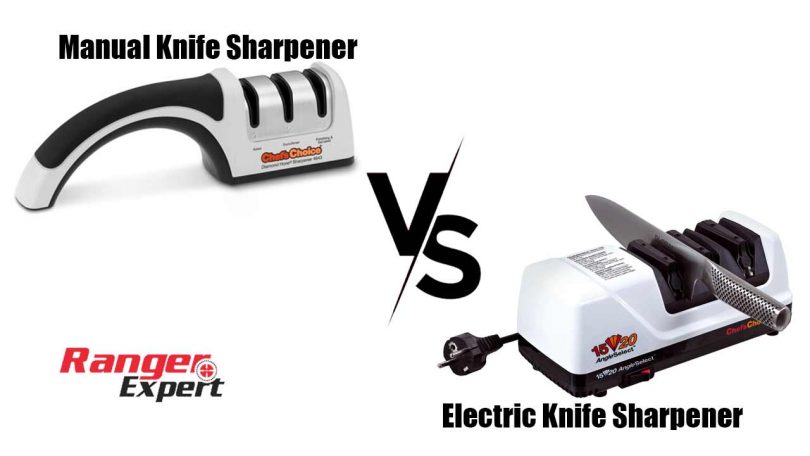



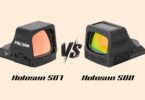
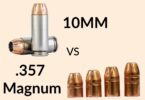


Leave a Comment